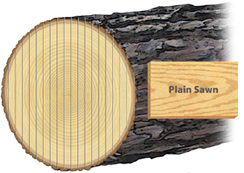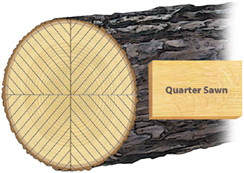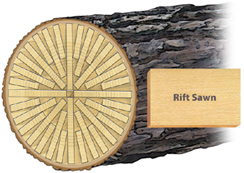Sawmills have several different ways of cutting timber into boards. Each sawing method produces a different look and durability, and comes at a different price.
The three traditional types of milled wood moulding are plainsawn, quartersawn and riftsawn lumber.

Plainsawn Lumber
In plainsawing, a sawmill cuts timber into long strips along its length, pulling off boards parallel to one another, like playing cards being separated from a deck.
Plainsawing creates the least waste of any sawing method, and is the least expensive, and most common method of sawing wood moulding.
Because each board comes from a distinct "slice" of the tree, each piece of plainsawn lumber has a distinct look and substance. As a result, moulding made with plainsawn lumber will have more variations than trim made from lumber cut by other methods. In extremes of humidity and temperature, these variations make plainsawn lumber more susceptible to expansion and contraction than quartersawn or riftsawn lumber.

Quartersawn Lumber
A "Quartersawn" log is first cut into four "quarters". Each quarter is then cut into boards through a series of cuts which are parallel to each other, but perpendicular to the tree's rings. The result is a series of boards, each containing a similar slice of the tree radius. Because quartersawing produces less board feet than plainsawing, quatersawn lumber is more expensive. However, quartersawn boards are more consistent than plainsawn boards. This makes them more resistant to shrinkage and expansion in humidity and temperature, and valuable to woodworkers. You can visually recognize quartersawn wood by its wavy grain patterns.

Riftsawn Lumber
Each riftsawn board is cut from the center of the log, outwards. Riftsawing is similar to quartersawing, except that each riftsawn cut is made at a slightly different angle. While this method of sawing creates many wedge-shaped scraps, it also results in boards with similar grain patterns; such boards have great uniformity and stability, even in extremes of temperature and humidity.
Riftsawing results in the least board-feet per log, making it the most expensive milling method.
Hardwood Grading
|